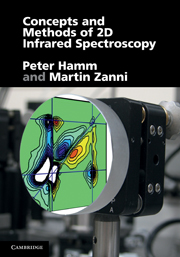Book contents
- Frontmatter
- Contents
- 1 Introduction
- 2 Designing multiple pulse experiments
- 3 Mukamelian or perturbative expansion of the density matrix
- 4 Basics of 2D IR spectroscopy
- 5 Polarization control
- 6 Molecular couplings
- 7 2D IR lineshapes
- 8 Dynamic cross-peaks
- 9 Experimental designs, data collection and processing
- 10 Simple simulation strategies
- 11 Pulse sequence design: Some examples
- Appendix A Fourier transformation
- Appendix B The ladder operator formalism
- Appendix C Units and physical constants
- Appendix D Legendre polynomials and spherical harmonics
- Appendix E Recommended reading
- References
- Index
9 - Experimental designs, data collection and processing
Published online by Cambridge University Press: 05 August 2012
- Frontmatter
- Contents
- 1 Introduction
- 2 Designing multiple pulse experiments
- 3 Mukamelian or perturbative expansion of the density matrix
- 4 Basics of 2D IR spectroscopy
- 5 Polarization control
- 6 Molecular couplings
- 7 2D IR lineshapes
- 8 Dynamic cross-peaks
- 9 Experimental designs, data collection and processing
- 10 Simple simulation strategies
- 11 Pulse sequence design: Some examples
- Appendix A Fourier transformation
- Appendix B The ladder operator formalism
- Appendix C Units and physical constants
- Appendix D Legendre polynomials and spherical harmonics
- Appendix E Recommended reading
- References
- Index
Summary
In the preceding chapters we have discussed many of the mathematical and logical underpinnings of 2D IR spectroscopy. In this chapter we focus on some of the practical aspects of implementing 2D IR spectroscopy in the laboratory and methods of processing the data. We have written this chapter assuming that our audience is already familiar with basic laser and ultra fast spectroscopic techniques and is interested in transitioning into the 2D IR field. The field of 2D IR spectroscopy is still growing and evolving. Improvements are continuously being made. Thus, some parts of this chapter may go out of date quickly, but at this time there is no commercial 2D IR spectrometer available nor is there a consensus on the best way of collecting multidimensional spectra, and so we think it prudent to discuss the design aspects of current 2D IR spectrometers, especially since the spectrometer design is tied closely with the theory.
Shown in Fig. 9.1 are some of the designs that have been invented so far for measuring 2D IR spectra. We have separated the designs into three categories, based on whether they operate in the frequency or time domains, or either. We have also divided this chapter into these same three categories. And, embedded throughout this chapter, are discussions pertaining to phase stability, data workup, and other issues pertinent to deciding how to implement 2D IR spectroscopy.
- Type
- Chapter
- Information
- Concepts and Methods of 2D Infrared Spectroscopy , pp. 176 - 216Publisher: Cambridge University PressPrint publication year: 2011



